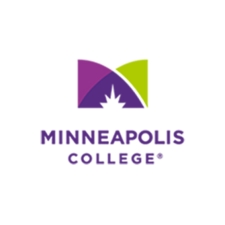
1501 Hennepin Avenue
Minneapolis, MN 55403
United States
Certificates / Diplomas
Associate Degree
About
Created in 1996, and a member of Minnesota State, Minneapolis College is the result of the merger of two institutions: a technical college with a long history of vocational education dating back to 1914 and an open-enrollment community college established in 1965.
Cost
Living Off-Campus
24,736
Average Net Price
$13,115 / year
This is the average annual amount that first-time, full-time undergraduate students pay at this institution after subtracting all grants and scholarships from the cost of attendance.
Show Net Price details
Net cost after grants and scholarships by income
$0-$30,000:
$12,634
$30,001-$48,000:
$12,759
$48,001-$75,000:
$14,111
$75,001-$110,000:
$15,709
Over $110,000:
$18,264
This net price data shows the average amount students have paid, according to their family income, after subtracting all grants and scholarships.
College Profile
Student/Faculty Ratio
19:1
Size of Student Body
5,973
Average Class Size
24
Show Undergraduate Student Body details
Breakdown by Race
American Indian or Alaska Native:
2%
Black or African American:
35%
Hispanic:
14%
Asian:
5%
White:
33%
Two or more races:
7%
International Students:
3%
Unknown:
3%
Breakdown by Age
19 and Younger:
21%
20 to 24:
34%
25 to 34:
27%
35 to 44:
12%
45 and Older:
6%
Breakdown by Gender
Men:
42%
Women:
56%
New entering students who are transfers
40%
Student Success
Graduation Rate for Two-Year Programs
17%
Show Graduation Rate 2-yr Institution details
Completers within 3 years by race
American Indian or Alaska Native:
17%
Black or African American:
9%
Hispanic:
13%
Asian:
17%
Unknown:
30%
Two or more races:
23%
Completers within 3 years by Gender
Men:
19%
Women:
15%
Retention Rate
57%
Show Retention Rate details
Retention Rate By Type
Full-time:
54%
Part-time:
45%
Campus Settings
Financial Aid
Average amount of federal, state, local, institutional or other sources of grant aid awarded to undergraduate students
$5,133
The following information pertains to first-time full-time undergraduate students.
Show Financial Aid details
Average amount of aid awarded to full-time first-time undergraduates
State/Local grant aid:
$1,156
Institutional grant aid:
$1,750
Federal grant aid:
$4,578
Average amount of grant aid awarded by income (all sources)
$0-$30,000:
$5,755
$30,001-$48,000:
$5,746
$48,001-$75,000:
$4,247
$75,001-$110,000:
$2,691
Over $110,000:
$611
School Scholarships
Yes
Financial Aid Contact
Cumulative Debt
This section shows the median debt graduates incurred to complete their degree at this institution.
Median Cumulative Debt by Degree Type
- Associate's Degree: $16,546
- Undergraduate Certificate: $9,500
Percent of Graduates With Loans
- Associate's Degree: 17%
- Undergraduate Certificate: 26%
Admission Information
Application Fee
$20
- Common applications (online)
- System applications (online)
- System applications (paper)
- School applications (online)
- High School Diploma or GED
- Transcripts
- Accepts dual credits
- Accepts exam-based credits
- Institution awards credits for military training
Application Timelines
Rolling Admissions Deadline
5th business day of the term.
Financial Aid Application Deadline
Varies by scholarship.
Admissions Contact
Robert Piurowski
Graduate Employment Outcomes
The data displayed below comes from the Graduate Employment Outcomes tool and only reports on graduates employed in Minnesota. This section shows employment data for graduate class of 2020, including percent of graduates with full-time employment in the 3rd year after college graduation and the median annual wages by award level, according to the Minnesota unemployment insurance records. Data does not include federal employees, self-employed (e.g. professional freelancers, artists, developers, designers, business owners), military, or individuals who moved out of state for a job. The list below may be incomplete and limited to some majors. Additionally, data has been suppressed when it refers to 10 or less students.Jump to:
This profile features institution-wide data. Be aware that some categories may not be showing and that data is suppressed when reporting is for 10 or less students. Most data and terminology is sourced from IPEDS. To learn more about each section, please refer to Data Sources.
The College Search Tool provides information and reported data for postsecondary institutions in Minnesota that receive federal and state financial aid. For licensed occupational training providers in Minnesota, please visit OHE's Licensed Career Schools.

